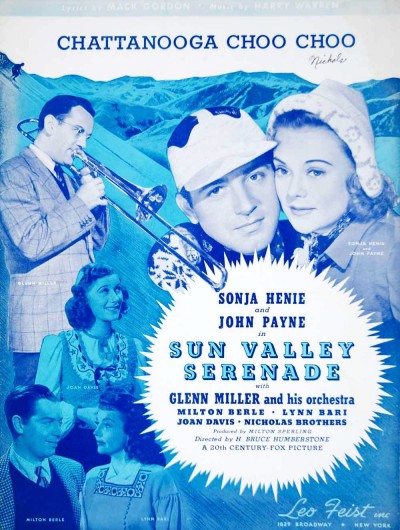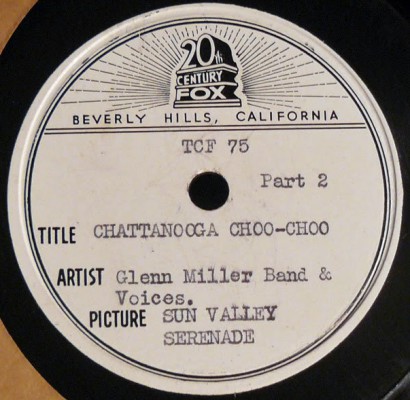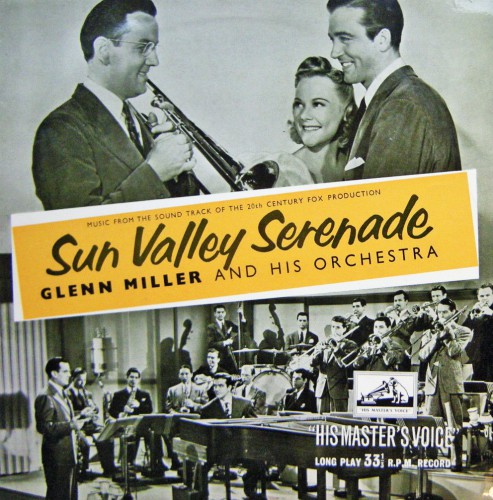Mickey McMickle, Johnny Best, Ray Anthony, Billy May (tp); Glenn Miller, Paul Tanner, Jimmy Priddy, Frank D’Annolfo (tb); Hal McIntyre, Wilbur Schwartz, Ernie Caceres, Tex Beneke, Al Klink (reeds); Chummy MacGregor (p); Jack Lathrop (g); Trigger Alpert (b); Maurice Purtill (d); Ray Eberle, Tex Beneke, Paula Kelly, The Modernaires, Pat Friday (voice dub for Lynn Bari), John Payne, Dorothy Dandridge, The Nicholas Brothers, Six Hits and a Miss (vcl); Bill Finegan, Jerry Gray, Billy May (arr).
Sun Valley Serenade soundtrack, 20th Century-Fox Studios , Hollywood, CA – March-April, 1941
Moonlight Serenade TCF-70
I Know Why (PF, JP & Mods vcl, JG & BF arr) TCF-70/71
In The Mood TCF-65
It Happened in Sun Valley (Mods & Six Hits vcl, BF arr) TCF-77
Chattanooga Choo Choo (TB, PK, Mods, DD & NB vcl, JG arr) TCF-74/75
At Last (PF & JP vcl, JG & BF arr) TCF-72/73
Sun Valley Jump (JG arr) RCA LPT-3064
The Spirit Is Willing (JG arr) RCA LPT-3064
Measure for Measure (BM arr) RCA LPT-3064
The World Is Waiting to Waltz Again (JP vcl, BF arr) TCF-76
The Kiss Polka (studio orchestra and chorus, no Miller) TCF-76
The TCF catalog numbers are for the contemporaneous 78 pressings made by Fox for publicity/souvenir purposes. First commercial issues are RCA LPT-3064 (10” LP issued 1954) and 20th Century-Fox 100-2 (2-LP set issued 1959). All further releases stem from these albums. RCA’s transfers are clean, but Fox adds a bit of reverberation to the tracks (and more echo on later issues).

The RCA LP is missing MOONLIGHT SERENADE, THE WORLD IS WAITING TO WALTZ AGAIN and THE KISS POLKA. I KNOW WHY and CHATTANOOGA CHOO CHOO are complete, including the Dandridge-Nicholas Brothers segment of the latter song, without overdubbed tap sounds. The Fox album includes the same numbers, minus this version of AT LAST. I KNOW WHY is missing the John Payne vocal portion and CHOO CHOO is cut short at the point where the commercial 78 recording ends.
————–

Sun Valley Serenade begins with the familiar 20th Century-Fox logo and fanfare. The next image is the Glenn Miller Band in silhouette, playing a swinging version of “The Kiss Polka” as the credits roll. Never before or since has a big band musical began with such an exciting introduction, which must have lifted audiences out of their seats as they got their first glimpse of the Miller Men. Most fans of the time had heard the band on radio and records, but only a relative handful had seen them in person, especially if they lived west of the Mississippi.

It doesn’t take long before we get more Miller – the band appears two minutes into the film and are playing their first number two minutes later. Glenn looks handsome but quite uncomfortable, smiling as he counts off MOONLIGHT SERENADE, which segues directly into I KNOW WHY (AND SO DO YOU). This gorgeous ballad, arranged by Bill Finegan, features close-ups of all the sections, beautifully lit and photographed. Trigger Alpert and Moe Purtill try not to look too self-conscious during Tex Beneke’s tenor solo and Glenn gets a terrific close-up immediately following. “Vocalist” Lynn Bari (wearing an extremely peculiar hat) and “pianist” John Payne are already making goo-goo eyes at each other, setting the plot into motion and the Modernaires pop up out of nowhere to back Lynn soothingly.

Veteran director Bruce Humberstone works a comic bit of business with Milton Berle and a cigarette lighter into the number. Humberstone graduated to “A” pictures with this one, after a spending a decade directing low-budget Charlie Chan and Jane Withers films for Fox. His smooth handling of Sun Valley Serenade led to his assignment to a batch of Technicolor Fox and Goldwyn musicals into the 1950s.
Sonja Henie makes her entrance as a rather overage Norwegian refugee, who is adopted by the band and John Payne as a publicity stunt. Henie is quite enthusiastic in her single-minded pursuit of Payne from the moment she lays eyes on him. With Lynn Bari also having the hots for Payne, this is the extent of the plot needed to keep an 82-minute film percolating.

At the 20-minute mark, Payne realizing he’s wanted on the bandstand and we’re into IN THE MOOD, the best-ever Miller performance of their signature number. Everybody gets their on-screen moment – Glenn, Tex, Al Klink, Billy May and Trigger Alpert & Moe Purtill, both mugging shamelessly. During the false fade-outs, the saxes and trombones do a choreographed routine, angling and tossing their instruments around, which was a crowd-pleasing stunt in live performance as well.
Henie and Bari bicker a bit over Payne, and then the performers are called back to the bandstand as we hear the introduction to AT LAST, which was unfortunately cut from the film, though home movies exist showing it being filmed. It’s a great arrangement by Jerry Gray and Bill Finegan, done here as a rhythm ballad, vocalized by Lynn Bari and John Payne. Payne sings for himself, rather reedily and Bari is doubled, as usual, by Pat Friday. RCA Victor issued the soundtrack performance on their Sun Valley Serenade LP in 1954. This wonderful song would be shelved and saved for the next Miller movie, this time in lush ballad mode. Both versions are knockouts.

With the band booked at the Sun Valley resort in Idaho, the whole entourage entrains to that pre-war luxury vacation setting, to the tune of IT HAPPENED IN SUN VALLEY. Riding sleighs to the hotel, the whole band joins in singing the catchy number, with the Modernaires augmented by the popular vocal group, Six Hits and a Miss, who were heard in many filmusicals of the era. Meanwhile, a visual montage shows all the amenities of Sun Valley – skiing, of course, along with horseback riding, heated swimming pools, outdoor dining and cocktail lounges – reality, but in the realm of fantasy for most Depression-era viewers.
Payne and Henie decided to go skiing, not aware that a rehearsal has been called. With band manager Milton Berle doing his best to placate a steaming Lynn Bari, the ensemble gets down to business with a full-out performance of CHATTANOOGA CHOO-CHOO. With Payne out of the way, Chummy MacGregor makes his only appearance in a Miller film (he would be replaced at the piano bench by Cesar Romero in ORCHESTRA WIVES).

This is the definitive performance of CHATTANOOGA CHOO-CHOO, performed in a relaxed groove, including many bits of the Jerry Gray arrangement that would be trimmed for the three-minute Bluebird version. The basic chart runs four-and-a-half minutes here, with the band beautifully photographed and charmingly natural vocal (and whistling) appearances by Tex Beneke, Paula Kelly and the Modernaires.

As the song winds down, we get a surprise – the camera pans past the band to reveal lovely young Dorothy Dandridge, quickly joined by the Nicholas Brothers. They are all in full costume, in front of a little “Choo-Choo” backdrop, taking another “hep” vocal chorus and dance. Dorothy then makes a beeline for the exit and the Brothers continue with more athletic moves as the band picks up the tempo. The overdubbed tap sounds mask a series of hot band solos, by Beneke, Billy May and Ernie Caceres. RCA’s later release of the complete, nearly 8-minute routine, reveals the solos without the taps.

The Nicholas Brothers with the Miller band.
There is only one brief shot of the Brothers dancing in front of the band; otherwise they are seen in isolation, an obvious ploy to keep Southern audiences and theaters from having to see what was termed “race mixing” at the time. Often sequences like this one would be cut, pure and simple, before Southern bookings. Since Dandridge and the Brothers have no part in the plot and simply appear and disappear without dialogue or on-screen explanation of any kind, a cut could have been made without notice.
At the 54-minute mark, that is pretty much the end of the Miller band in the film, though Glenn acts in several later scenes, appearing a little stiff, but good enough. The rest of the music – THE KISS POLKA, performed at the ski lodge, a lovey-dovey reprise by Henie and Payne of I KNOW WHY and Henie’s two skating routines are performed by the Fox studio orchestra and chorus, though the final ice ballet shows the Miller band (in tuxes) now and then to create the illusion that they are playing on the soundtrack. Interestingly, AT LAST is heard again during the ballet, suggesting that it’s earlier band performance was likely cut at the last minute. Jumping the gun, Ina Ray Hutton’s band recorded AT LAST for Okeh in July, with the label credit, “from Sun Valley Serenade.”

Joan Davis in the cut number, I’M LENA THE BALLERINA.

Posed still from I’M LENA THE BALLERINA.
Several other performance numbers were filmed and cut – I’M LENA THE BALLERINA, a comic solo for Joan Davis that was slotted in before THE KISS POLKA at the ski lodge with no Miller involvement; and THE WORLD IS WAITING TO WALTZ AGAIN, a lovely, timely war-tinged ballad sung by John Payne during the ice finale sequence with the Miller band, augmented by strings. A tiny glimpse of LENA appears in the movie’s trailer; several stills and home movies exist showing WALTZ being filmed. Happily, the soundtrack of the latter number still exists and can be heard here.
Without her song, sixth-billed Joan Davis has less than two minutes of comic byplay with Milton Berle remaining in the picture. The film’s wrap-up is also remarkably hurried, with no final kiss or declaration of love between Payne and Henie. She skates, a quick shot of them skiing and “The End.” As the film runs only 82 minutes, there certainly was time for more music and action; reportedly, studio head Darryl Zanuck was tired of Henie’s demands and wouldn’t allow any more time or budget to be lavished on the film. It went on to be Henie’s biggest hit, anyway, with much of the success due to the presence of Glenn and the boys.

Several other instrumental numbers were recorded at Fox, likely planned for underscoring, but none were heard in the finished film. SUN VALLEY JUMP and THE SPIRIT IS WILLING are the same Jerry Gray arrangements recorded for Bluebird in January and February. The film rendition of JUMP is faster and swingier, but as usual, cuts the Al Klink solo heard on the record. THE SPIRIT IS WILLING is almost indistinguishable from the RCA 78. MEASURE FOR MEASURE is a Billy May riff flagwaver, which Glenn played often on the air but only recorded here. The rhythm section really jumps and solos by Caceres (on alto), Beneke and May add to the excitement. A slow dynamic buildup from a diminuendo passage spotlights Trigger Alpert’s powerful bass playing.

Sonja Henie and Lynn Bari flank John Payne in his ski sweater.
Sun Valley Serenade was also influential in unsuspected ways. It started a craze for embroidered ski sweaters, as worn by John Payne and several of the bandsmen. As one of the very few American films reportedly released in the Soviet Union during and after the war, the Miller music was appreciated and copied by Russian jazz musicians, starved for modern swing sounds. As late as the 1970s, Soviet dance bands were still performing and recording the film’s tunes, sometimes in lavish, string-laden symphonic arrangements!

Soviet recording of SUN VALLEY tunes by Oleg Lundstrem’s Orchestra.

Promotional flyer for the postwar German release of SUN VALLEY SERENADE.
At the conclusion of filming in early May 1941, the Miller Band could finally emerge from its enforced isolation in Hollywood. During the movie, they had maintained their schedule of Chesterfield broadcasts, but made hardly any personal appearances. Now they could begin to perform on this first visit to the West Coast. The hungry fans were ready for them!

Glenn looks dapper and movie-star handsome in the film. Catch that wild tie!































